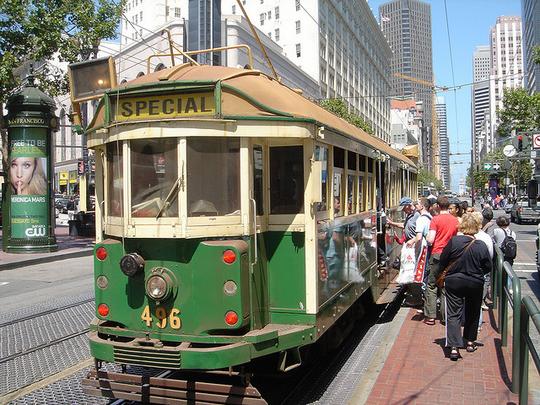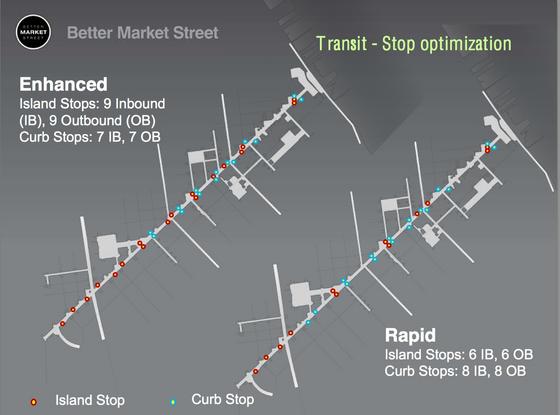As we’ve mentioned, Market Street Railway is one of the many stakeholders involved in the Better Market Street Project. The project was triggered by the need to physically repave our main street, but has grown into a wide-ranging re-envisioning of Market, with a process that includes four city agencies, a dozen consultant companies, and numerous interest groups (including us, the Bicycle Coalition, pedestrian advocates, business groups and more).
The city team leading the effort presented a status report to the SFMTA Board of Directors the other day. Stories about it appeared in both the Chronicle/SF Gate and SF Streetsblog. Both, however, missed what we think is the most important story for transit riders: possible elimination (or “consolidation”) of stops on Market between Octavia Boulevard and Steuart Street, the boundaries of the project.
Currently, there are 12 island stops in each direction in that stretch for the F-line streetcars. The presentation slide above (click to enlarge it) shows two options for reducing the number of island stops. (A third option is to leave the stops just as they are.) The “enhanced” option would remove three of the 12 stops (a reduction of 25%). The “rapid” option would cut the number of F-line stops in half, leaving just six, mostly aligned with the BART-Muni Metro stations, and perhaps relocated from street corners to mid-block. (Don’t take this slide too literally. For example, it shows no island stops between Third and Drumm Streets, leaving both the Montgomery BART Station and the new Transbay Terminal unserved — inconceivable that’s not a mistake.)
This concept was presented to us a couple of weeks ago by Muni staff. As they explained it then, the idea would be to speed up downtown service on the most heavily-used surface routes, including the F-line and two or three arterial bus routes (possibilities include the 9-San Bruno and the 71-Haight-Noreiga), in effect making them Limiteds through downtown. Other Muni lines would run in the curb lane with more frequent stops and would in effect serves as Locals.
As part of the transformation, the remaining islands would be made longer and, where possible, wider, eliminating the few that are not currently ADA accessible. Prepayment could be instituted, as at T-line stops, and traffic signals could give priority to the track lane Muni vehicles. You can ([view or download the entire presentation here]:(http://www.sfmta.com/cms/cmta/documents/6-19-12item13bettermarketst.pdf))
This project does not affect stop spacing on the rest of the F-line. On upper Market, the F is the only surface line, the Metro stations are farther apart than they are downtown, and the street grades make walking greater distances less comfortable for many. So F-line stops every block seem appropriate to us there. We’re intrigued, though, with the concept of reducing the number of stops along that part of Market where there are several lines serving the curb lane to carry riders going only a block or two. It makes some sense to focus on speeding up lines that people tend to ride a long distance, including the F. But there are tradeoffs involved, as noted in the project’s own Design Drivers report (p. 13): “…recognize that best practice evidence cautions against long stop spacing for local stop services in a downtown environment.”

One of the busiest F-line stops, Wharf-bound at Fourth and Market, is too narrow to allow an ADA ramp, thus denying access to disabled people. That’s because the boarding island, which predated ADA and is thus "grandfathered," sits parallel to a BART/Metro escalator entrance, which narrows the street. Moving some downtown F-line stops to mid-block would allow wider islands with ADA access and faster boarding for all riders, while leaving more space for other street users by removing the current constrained islands.
While the actual work on Market would not begin until at least 2016, it’s very important that F-line riders and supporters take the time to study the options and make their views known now…both to us, through comments on this post, and directly to the city team. They will be holding two public workshops and a webinar in mid-July. Details here.
Experience with these kinds of projects shows that those who are at the table early can have the greatest influence. This is your chance to make your voice heard on how the F-line will operate through downtown for decades to come. Take advantage of it!
For our part, we will be listening carefully to feedback from our members, whose support makes our advocacy possible, so if you’re already one, either post your comment below or send us an email. If you’re not, we invite you to join Market Street Railway.
We’ll share our position on future F-line downtown stop spacing with you here when we have formulated it. In the Better Market Street Project, we are fully supportive of better bicycle and pedestrian environments on Market (yes, at the expense of further reductions — though not necessarily elimination — of automobile traffic). However, our primary focus, as you’d expect, is on improving the rider experience and efficiency on the Muni lines that serve Market, most especially, of course, the F-line.

I’m all for faster transit. Stops spaced two blocks apart mean that you walk up to 1 block in worst case and get on fast transit. You can always get on a slow bus if you can’t walk far and either stay on it or transfer. Current muni metro spacing is pretty good right now in that regard.
As a docent who volunteers at the 4th & 5th Street stops, I have first-hand experience in what slows Muni lines down in that area. In addition to pre-payment, better signs are badly needed, especially for the tourists. By “better” I mean signs that prominently specify what the fare is, that exact fare is required, which direction Fisherman’s Wharf is, what bus to take to get to the Haight, and that the J through N lines are in the subway. Fumbling for exact fare and asking the operator directions slows the lines down. Having signs in tourist-heavy areas be in English, French, German, Italian, and Spanish would also help.
In some places around the world, the trams are next to the sidewalk. I would like to see this on Market street with lavish covered structures on the sidewalk. I think mid-block stops are a good idea and would like to see buses in the center and all auto traffic rerouted to Mission street. Befsore any decision is made, I would hope that someone would go to Europe and video the set-ups there. Our beatiful renewed cars should be showcased and made the focal point of Market Street. Some of the waiting areas could actually look like parts of the PCC cars with windows like in the cars and seats like inside the cars and nostalgic advertising. thanks for letting me express myself – Frank W.
Wider stop spacing — a couple blocks, not half a mile, of course — makes a lot of sense. Clearer branding for the remaining stops is the other side of the equation
ALL stops must be ADA compliant. but the F line is a tourist oriented line, if your really in a hurry go to the metro downstairs.
since there are a lot of tourists and short hop locals on board I do not think the stops should be much further apart than they are now. seniors, and others find walking even two blocks quite a challenge. the F line is the “local” the J K L M N lines are the expresses. getting rid of most cars on market would be a godsend. and maybe limiting market street surface lines to streetcars and trolleybuses only. the lack of diesel fumes would improve things a lot too.
Personally I think the F-line should only stop at important stops and transfer stops between Octavia and Steiner. The upper leg of the F-line serves as a local route which should remain. Between the Embarcadero and Octavia there are multiple existing ways to make short trips and those should be used. Additionally – this portion of Market has wide side-walks and a rich pedestrian culture – that should be encouraged all the way to Octavia. The Mid-Market area already has a plan, but the blocks from 11th to Octavia are long and have some less-desirable sections. Those would be cleaned up quickly with more pedestrian use and less drive-by traffic.